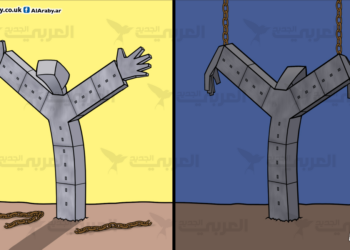Fadel Abdulghany
The EU sanctions regime on Syria represents one of the most comprehensive and sustained multilateral sanctions regimes of the 21st century, spanning fourteen years of escalating restrictions.
Following the sudden fall of the Assad regime in December 2024, the European Union took a historic step by shifting away from its sanctions policy, lifting most economic restrictions while maintaining specific measures targeting individuals and entities associated with the former regime.
This shift marks a significant milestone in EU foreign policy and provides strategic insights into the effectiveness of using economic sanctions as tools in international diplomacy and the protection of human rights.
Historical development of European sanctions on Syria (2011–2024)
The European sanctions on Syria came in response to the Assad regime’s brutal crackdown on peaceful protesters who took to the streets in March 2011.
The first formal sanctions were imposed by European Council Decision 2011/273/CFSP of 9 May 2011, which represented the first official European condemnation of “the violent repression and use of live ammunition against peaceful protests in various parts of Syria, resulting in the killing, wounding, and arrest of a large number of demonstrators.” This decision formed the legal basis for a comprehensive sanctions regime targeting both individuals and vital economic sectors.
The initial package of sanctions focused on asset freezes and travel bans against individuals directly responsible for human rights violations. However, the EU quickly realized that these measures alone were insufficient to address the escalating crisis. Therefore, it significantly expanded the scope of the restrictions in December 2011 through Decision 2011/782/CFSP, which built on the European Council statement of 23 October 2011, in which it declared that the EU “will continue to impose further measures on the Syrian regime as long as it continues to repress civilians.”
Expansion of Sectoral Sanctions
European sanctions on Syria have gradually escalated in line with the deterioration of the humanitarian situation and the escalation of the conflict. In 2013, the general framework of sanctions was consolidated by European Council Decision 2013/255/CFSP, which imposed broad sectoral restrictions covering arms trade, dual-use goods, internal repression equipment, and surveillance technologies.
This shift represented a strategic shift from limited individual sanctions to broader economic restrictions aimed at undermining the regime’s ability to continue, while attempting to mitigate the impact on civilians as much as possible.
These sanctions covered vital areas of the Syrian economy, including energy exports, financial services, and the trade in luxury goods. They were specifically designed to limit the regime’s ability to finance its military operations and also targeted the economic interests of the regime’s regional and international backers.
It also included exceptional measures for humanitarian exemptions, recognizing the humanitarian difficulties that could arise from comprehensive sanctions, to ensure the continued delivery of aid and essential services to the population.
Legal Framework and Decision-making Mechanism
The European sanctions were based on Article 29 of the Treaty on European Union, which constitutes the constitutional framework for the Common Foreign and Security Policy. These sanctions were implemented through a dual legal structure, consisting of Council decisions on foreign policy and Council regulations that were directly applicable in the national legal systems of the member states. This dual framework enabled political consistency at the EU level and ensured effective implementation at the domestic level.
The decision-making process requires consensus among member states within the Council, reflecting the governmental nature of European foreign policy. The legal framework for sanctions has been subject to periodic reviews, and the last extension, prior to the collapse of the Assad regime, was scheduled to last until June 1, 2025, allowing for policy updates based on developments on the ground and performance assessments.
Scope and Types of Restrictive Measures
European sanctions on Syria encompass a wide range of measures targeting various elements of the Syrian economy and political structure. These sanctions include a comprehensive arms embargo, including a ban on the sale, supply, or transfer of military equipment and dual-use goods that could be used for internal repression.
An expanded asset freeze was also imposed, targeting 318 individuals and 58 entities linked to the regime, along with a travel ban preventing them from entering or transiting through the European Union.
These measures extended to vital economic sectors such as energy, transportation, financial services, the luxury goods trade, and the protection of Syria’s cultural heritage.
It also targeted advanced surveillance and communications interception technologies to prevent their use in human rights violations. This framework is one of the most independent and broad sanctions regimes the EU has imposed on a country outside its borders.
Implementation and Compliance Mechanisms
Implementing sanctions on Syria requires close coordination between EU institutions and member states’ national authorities. These authorities are tasked with monitoring compliance, investigating violations, and imposing sanctions on violators. Due to the particular complexity of sectoral sanctions and humanitarian exemptions, regular guidance and updates are issued to ensure consistent implementation across member states.
The effectiveness of enforcement mechanisms varied depending on the type of restrictions imposed. While individual sanctions, such as asset freezes and travel bans, were more straightforward and easier to implement, sectoral sanctions, particularly in the energy and financial services sectors, faced greater implementation challenges.
Numerous reports have indicated that humanitarian organizations have repeatedly encountered difficulties in navigating the terms of humanitarian exemptions, which has impacted the effective delivery of aid in some cases.
The fall of the Assad Regime and a Reassessment of European Policy Towards Syria
The sudden collapse of the Assad regime in December 2024 opened a window for a comprehensive reassessment of the European Union’s policy towards Syria. The European Council’s conclusions of December 19 of the same year affirmed “the historic opportunity available to all Syrians to reunite and rebuild their homeland,” emphasizing the importance of launching an inclusive political process that responds to the legitimate aspirations of the Syrian people. This shift marked the starting point for a profound review of the sanctions regime that had been in place for over thirteen years.
The European response was accompanied by a mixture of caution and optimism regarding the future of the transitional phase, emphasizing the need for the political process to be “purely Syrian,” while respecting Syria’s independence, sovereignty, and territorial integrity in accordance with international law.
Gradual Approach to Sanctions Relief
Rather than lifting sanctions all at once following political change, the EU has opted for a gradual and reversible approach, aiming to support Syria’s transition while maintaining leverage to ensure continued progress towards democratic governance.
This approach began to be implemented on February 24, 2025, when the Council decided to suspend a number of restrictive measures due to the field and political developments in Syria, to facilitate communication with the Syrian people and companies operating in key sectors such as energy and transportation.
The initial suspension covered specific sectors deemed vital to economic recovery and meeting urgent humanitarian needs. These measures included suspending sectoral restrictions on energy and transportation, removing five banking institutions from the sanctions list, introducing additional banking exemptions to facilitate humanitarian activities and reconstruction projects, and extending previous humanitarian exemptions indefinitely.
The Political Decision to Lift Comprehensive Sanctions
On May 20, 2025, the European Union officially announced its political decision to lift economic sanctions, after months of assessing the situation under the transitional government.
The Council’s statement said, “The time has come for the Syrian people to reunite and build a new Syria, based on inclusiveness, pluralism, and peace, and free from harmful foreign interference.”
This decision represented a fundamental shift in the European Union’s approach from a policy of pressure and containment to providing actual support for the democratic transition process in Syria.
However, the resolution retained important safeguards, most notably the continued imposition of sanctions on individuals and entities associated with the former regime, the maintenance of security restrictions on the export of sensitive weapons and technologies, and the existence of mechanisms to reimpose sanctions if the human rights situation deteriorates.
Current Sanctions Framework and Implementation Mechanisms
Sanctions Framework: The decision to lift sanctions was implemented through a package of legal measures adopted by the European Council on 28 May 2025, including Council Decision (CFSP) 2025/1096 and Council Regulation (EU) 2025/1098, which introduced amendments to the basic legal framework in force since 2013.
The adoption of these measures was the result of a careful political process within the European Union, providing the legal basis for European companies and organizations to resume their activities in Syria.
The new legal framework addresses various categories of previously imposed economic restrictions, and has officially lifted them from the energy, transportation, and financial services sectors, in addition to most other trade restrictions.
As part of the sanctions lifting process, the European Union removed 24 entities from its sanctions lists, including banking institutions and companies operating in strategic sectors such as oil production and refining, the cotton industry, telecommunications, and media.
The most prominent of these entities was the Central Bank of Syria, which enabled the resumption of international banking relations and facilitated widespread economic transactions. These entities were selected after careful consideration of their role in the economic recovery process compared to their ties to the former regime.
Remaining Restrictions and Security Concerns
Despite the broad lifting of economic sanctions, the EU has maintained a range of restrictions in response to security concerns and accountability issues. These include the continued arms embargo, export restrictions on dual-use goods and equipment, restrictions on surveillance and interception technologies, and a ban on trade in Syrian cultural heritage. These measures reflect ongoing concerns that these tools could be used for internal repression or threaten regional stability.
The European Union also maintained sanctions on 318 individuals and 58 entities linked to the Assad regime, extending them until June 1, 2026. These sanctions include asset freezes and travel bans imposed on those responsible for human rights violations, reaffirming the EU’s commitment to achieving justice while avoiding holding the Syrian people collectively responsible for the crimes of the former regime.
Strategic Implications and Future Prospects
The EU’s experience with sanctions on Syria provides important lessons about the opportunities and challenges associated with using long-term sanctions regimes.
This experience demonstrates the limits and potential of economic sanctions as a tool to promote political change and protect human rights. Although sanctions did not alone bring down the Assad regime, they contributed to weakening it and undermining its international legitimacy, while also highlighting the European Union’s continued commitment to human rights within its foreign policy.
The shift from sanctions to support underscores the importance of flexibility and the ability to adapt to rapid political changes. It also highlights the EU’s institutional capacity to respond strategically to sudden changes.
At the same time, the humanitarian side effects of comprehensive sanctions reveal the need for more nuanced and balanced approaches between pressuring authoritarian regimes and ensuring the protection of civilian populations.
Regional Stability and International Coordination
The implications of the transitional phase in Syria extend to regional stability in the Middle East as a whole, and the European Union’s policy on sanctions represents a central element within broader international coordination efforts.
The alignment of European sanctions relief with similar measures taken by the United States and other countries contributes to enhancing the effectiveness of the international response and reducing the chances of circumventing sanctions or diverging political messages.
This coordination enhances the international community’s ability to support the political transition process in Syria without compromising the goals of accountability and ensuring respect for human rights.
The European Union’s emphasis on the need to prevent “harmful foreign interference” also reflects its concerns about the potential negative influence of some regional powers on Syria’s internal political process. The current sanctions framework, both lifted and maintained, is a means of strengthening Syrian sovereignty and deterring attempts to undermine the transitional phase.
Challenges and Risks Associated with Implementation
Despite the positive steps taken to ease sanctions, the European Union’s policy toward Syria faces real challenges in implementation and monitoring. The transition from a comprehensive sanctions regime to specific measures requires close monitoring and strict enforcement to prevent the new facilities from being exploited by entities linked to the former regime or implicated in human rights violations.
Likewise, the EU’s commitment to making its sanctions relief policy “reversible” provides strategic flexibility, but at the same time creates uncertainty for companies and organizations wishing to resume their activities in Syria.
Striking the right balance between supporting economic recovery and ensuring accountability is an ongoing political challenge, requiring careful and continuous evaluation of the policy tools adopted. The success of this approach will depend on the transitional government’s commitment to inclusive governance standards and respect for human rights.
Conclusions
The European Union’s sanctions policy towards Syria embodies a complex and multi-dimensional response to one of the most urgent political and humanitarian crises of the 21st century.
As Syria seeks to restore political stability and achieve a genuine economic recovery, the EU’s shift from sanctions to support highlights the complexities of international relations and the continuing role of multilateral diplomacy in addressing global challenges.
The Syrian situation is likely to shape the EU’s future approach to sanctions, humanitarian support, and post-conflict assistance, thereby enhancing the development of European foreign policy tools.






